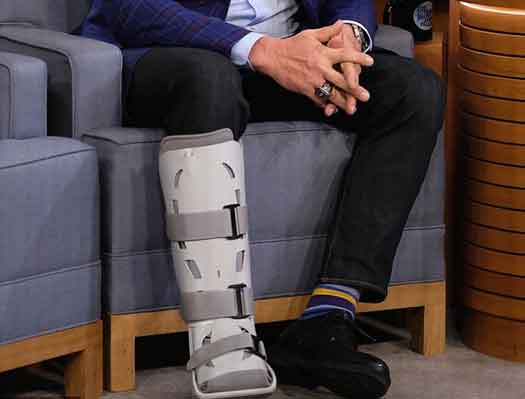
Nearly everyone suffers at least a minor ankle strain at some point in their lifetime, and knowing how to wrap your foot with an Ace bandage is a good idea.
It makes perfect sense to learn how to wrap an Ace bandage because ankle sprains are common.
The odds of injury increase the more active you are. However, it is not an excuse for you not to exercise. The health benefit of exercise far outweighs the negative of picking up an injury.
This article will briefly explain how to wrap or treat a strained or sprained; you never know when you will need this skill to help a family member, yourself, or a friend.
The RICE method in shorts
If you have ever had a sprain and went to the doctor, you will know of the RICE method. This RICE method is a handy little acronym to help you remember to rest, ice, compress and elevate your leg after an injury to lessen the discomfort caused by the injury.
Here is a brief explanation of the rice method and the reason for it.
Rest: After an injury, you have to rest to avoid the possibility of further aggravating the injured joint. Rest is easy; just stop moving. You may be in shock and start trying to prove to your brain that you are not injured, but you are and may make matters worst if you persist in not resting.
Ice: you’ve got to ice the foot to reduce the pain and resulting swelling. You do not have to buy an ice pack for this unless you want to look fancy. You can put ice in a bag, wrap it with a thin towel and then rest it on the injured leg.
Compression: Compression provides a means of stabilizing the joint and protects from further injuries during the first 24-48 hours of the injury occurring. You can use an Ace Bandage for the stabilization. Later, in the article, a brief explanation will be given and includes how to wrap a sprained ankle properly.
Elevation: Elevation is a method used to reduce the swelling of your ankle. You may have to elevate the leg a little to ease the pain or swelling. You can do so easily by propping your foot up on a stool, chair, or something. It will make your ankle feel much better.
What Is An Ace Bandage?
ACE Bandages are elastic wrap used for snugly wrapping an injured joint to offer compression and aid in swelling reduction. The ACE Bandage has been in use since the early 1900s and is a trusted medical product.
ACE Bandages come in a roll with metal clips and tape to use as a fastener to hold the bandages in place. It comes in various sizes for convenience purposes.
ACE Bandages can also serve as a way to secure an ice pack on an injured body area. It can also keep other bandages and splints in place after a fracture or severe sprain.
Please be advised that ACE Bandages are not for covering open wounds. The wound must be clean and dressed before applying the ACE Bandage.
How to wrap your foot with an Elastic Cloth Bandage
According to Dr. Vikki of doctorvikki.com, this is how you secure a foot using a cloth bandage. She said it perfectly. You can visit her site here for more information if you like.
- Begin wrapping—place the end of the bandage where the toes meet the foot. Begin by wrapping the bandage around the ball of the foot. Hold the end of the bandage against the ball of the foot with one hand, and use the other to bring the tail around the foot from the outside. Make sure to keep the bandage tight, but not so tight that it decreases blood flow to the foot and toes.
- Work your way toward the ankle—wrap the ball of the foot twice to hold the bandage in place, then begin moving up towards the ankle, being sure to leave at least one-half inch of bandage overlapping the previous layer. Make sure the layers are smooth and even with no unnecessary bulges or lumps. Start over if you need to do the job more neatly.
- Wrap the ankle—when you get to the ankle, bring the end of the bandage up outside of the foot, over the instep and around the inside of the ankle. Then bring it around the heel, back up over the instep, under the foot and around the ankle. Continue making a figure eight around the ankle several times to stabilize the ankle fully.
- Finish the wrap—the last wrap should rise several inches above the ankle to help stabilize it. Use the metal fasteners or medical tape to secure the remaining bandage. Tuck, the excess bandage under the last layer, provided there’s not too much excess.
When used properly, the ACE Bandages will help reduce swelling and pain around an injured joint by restraining the loose joint.
When Should I Wear An Ace Bandage?
Using ACE Bandages is a good idea when swelling in an injured area of the body needs addressing. If you have a wound with bandages on that need to be held in place, it is a good idea to use an ACE Bandage.
ACE Bandages do a good job holding a splint and ice packs in place on injured body parts.
How To Wrap Your Foot With An Ace Bandage?
How To Wrap A Sprained Foot With An Ace Bandage?
A compression wrap is used to prevent swelling, which can help your ankle feel better. Compression wraps do not support the ankle or prevent movement, so it does not protect it from injury.
Here are the instructions on how to wrap a sprained foot with bondage by my.health.alberta.ca. You can visit their site here. In the meantime, read the instructions they provided below:
- Roll up the elastic bandage if it isn’t already rolled up. Hold your ankle at about a 90-degree angle.
- Start where your toes meet the body of your foot. Hold the loose end of the bandage at the side of your foot.
- Wrap the bandage around the ball of your foot once, keeping it somewhat taut with a light pull.
- After this, slowly start circling your way around the arch of the foot. Pull the bandage diagonally from the bottom of the toes across the foot’s top and rotate it around the ankle.
- Now bring the bandage diagonally across the top of the foot and under the arch in a figure-eight pattern.
- When you get to the ankle bone, wrap the bandage around the felt piece, so it stays in place under the ankle bone.
- Continue around the ankle and foot in a figure eight, moving toward the heel on the bottom and toward the calf at the top of the eight.
- The wrap should cover the entire foot and end about 7 centimeters above the ankle.
- Most compression wraps are self-fastening or come with clip fasteners. If not, use tape to secure the end. The wrap should be snug but should not cut off circulation to the foot.
How Long Should An Ace Bandage Stay On?
Use the ACE Bandage in the first 24 to 48 hours after an injury. This is because the bandage is compressing an injury limits blood flow, alleviating pain and swelling.
For the injured area to fully heal, the bandage needs to loosen. Loosening the bondage on your foot encourages the return of normal blood flows back in the veins.
If the pain and swelling do not subside after a day, seek help from a doctor. Instability in the ankle or a popping sensation indicates that a visit to the doctor is needed.
Should I Wrap A Sprained Ankle At Night?
The best way to heal an injured ankle is to rest and keep off of it as much as possible. So nighttime is an ideal recovery time for an injured ankle.
During the day, the ACE Bandage on a sprained ankle is snug and firm against the leg, but the bandage needs to be loosened at night to improve blood circulation.
It is also a good idea to elevate the ankle while sleeping. The ankle should be raised to about heart level to reduce swelling and pain. A pillow or cushion under your foot at night is an excellent way to elevate the injured joint above your heart. Get a good leg elevation pillow.
Should You Sleep In An Ace Bandage?
ACE Bandages are best used during the daytime only and removed before bedtime. Supports and braces for sprains are mainly helpful for daytime joint support and protection.
It is preferable not to wear an ACE Bandage overnight because it provides compression and heat retention.
However, if you are experiencing a great deal of pain and get some relief from keeping your ankle wrapped at night, an elastic bandage should help.
However, other sources say it’s OK to wrap your foot at night; the precaution is to make sure that the bandage is very loose.
An ACE Bandage should only be worn at night if a physician recommends it. If your ankle doesn’t feel better after a few days of home care, see your doctor for professional help.
It is better to be safe than sorry; swelling and pain for extended periods may mean that you are dealing with a more severe injury.
Conclusion
I hope you find this content helpful. If you need more specific ideas, visit your medical professional. If you get an injury, now you know how to wrap a foot with an ace bandage.
Thanks for vising bootwalker.com are reading about the ace bandage.






